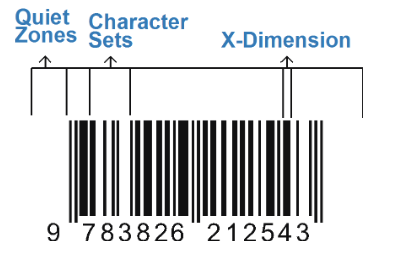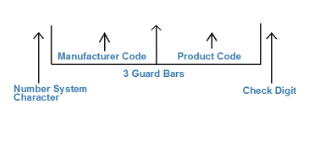What Is a Barcode in Simple Words?
A barcode is a pattern of dark bars and gaps grouped in some pattern to encode data characters. Every barcode type or symbology has its unique way of encoding data characters. The general format of a barcode symbol consists of a leading margin, start character, data or message character, check character (if any), stop character and trailing margin. Within this framework, each recognizable symbology uses its unique format.
What Types of Barcodes Are There?
Barcodes are divided into two main types: one-dimensional (1D) and two-dimensional (2D). 1D barcodes, also known as linear barcodes, consist of lines and spaces of various widths that create specific patterns representing information. 2D barcodes, on the other hand, use symbols, shapes, dots and other geometric patterns to store data, which can be scanned both horizontally and vertically, allowing them to hold much more information than 1D barcodes.

This is a conventional 1D barcode. It has a single row of bars – similar to a picket fence. It is called 'one dimensional' because all the data is encoded in the horizontal width.

This is a two dimensional barcode. Data is encoded in both the horizontal and vertical dimensions. As more data is encoded, the size of the barcode can be increased in both the horizontal and vertical directions thus maintaining a manageable shape for easy scanning. This type could have 2000 or more characters embedded in the barcode.
Barcodes can be further divided into symbologies, or barcode languages, which support different types and amounts of data
1D
UPC Code

Primary Purpose:
Keep track of sales and inventory of retail products sold within the US and Canada
Contains (minimum requirement):
12-digit number that identifies the specific product
Requirement:
Required for OTC items
Linear

Primary Purpose:
Reduce medication errors
Contains (minimum requirement):
NDC
Requirement:
Linear barcode required on nearly all drug products in the US
2D
Data Matrix

Primary Purpose:
Identify and trace certain prescription drugs as they are distributed in the US
Contains (minimum requirement):
NDC, serial number, lot number and expiration date
Requirement:
2D data matrix required on the smallest saleable package
Quick Response (QR)

Primary Purpose:
Provide information (website nutrition information, etc.) about the product to which it is affixed
Contains (minimum requirement):
Not applicable
Requirement:
Not required by FDA on product labels and labeling
How Do Barcodes Work?
A barcode holds encoded information and a barcode scanner is able to translate this code into numbers and letters which is passed onto a host system.
Barcodes provide rapid, simple and accurate readings, as well as data transmission for items that need to be identified, tracked or managed. They can be directly printed onto virtually any material and provide a cost-effective and accurate solution for capturing data. There is no single barcode type that has a universal business application. Therefore, a need for different symbologies exist.
When you breakdown a barcode, character sets are combinations of bars and spaces that represent a specific character. X Dimension is the width of the smallest bar or space element in the barcode which is also referred to as mil size (1mil = .001 inch). Quiet ones are the areas just before and after the barcode.

What Are the Parts of a Barcode?
Each barcode holds specific information that can be used to identify a product, track inventory, and manage pricing. Starting from the beginning of the barcode, the very first number is known as the system character or number system character. This digit is not randomly assigned; rather, it serves as an identifier for the type of product or industry the product belongs to. For instance, a barcode that starts with the number '0' typically represents a grocery item, whereas a barcode that begins with the number '3' indicates that the product is a pharmaceutical item. Several other system characters correspond to different industries.
Beyond the system character, a barcode contains a series of numbers grouped into sections. These sections include the manufacturer or company code, the product code, and a check digit. The manufacturer code is assigned by a central organization, GS1, and is unique to each company. This allows the barcode to identify which company produces the product. The barcode will contain a manufacturer code/company prefix which is from six to ten digits in length and is a globally unique prefix assigned to the company. This ensures that a product’s barcode is not confused with another company’s product.
The product code, on the other hand, is assigned by the manufacturer to each of its products. This code is unique for each product and helps in identifying the specific item within a manufacturer's line of products. The product code/item reference is a unique code assigned to the product and combines with the manufacturer code to make up the first eleven digits of the barcode.
The check digit is the last number in the barcode and it is used for error detection. The scanner uses this digit to verify that the barcode has been scanned correctly. A check digit is a special formula using those first eleven digits to calculate the check digit. This twelfth digit ensures the accuracy of the information in your barcode when it is scanned.
It's important to note that the actual price of the product is not encoded in the barcode. Instead, when the barcode is scanned at the point of sale, the system uses the manufacturer and product codes to look up the price in the store's database. This allows for dynamic pricing, where prices can be changed in the database without requiring new barcodes on the products.
Additionally, the barcode system also allows for efficient inventory management. As products are sold and their barcodes scanned, the system can automatically update the inventory levels. This helps retailers track their stock levels in real-time and can assist in forecasting future inventory needs.

What Are the Types of Barcode Scanners?
There are three types of scanning technology, Laser Scanner, Linear Imager and Array Imager:
Laser Scanner
A laser scanner can read 1D printed barcodes but cannot read mobile. It is also unable to scan 2D codes or capture images but it does provide good performance on poor quality codes along with omni-directional scanning. These types of scanners tend to be a good and affordable option for standard, good quality 1D printed barcodes.
Linear Imager
A linear imager can read 1D printed and 1D mobile barcodes but cannot scan 2D code nor is omni-directional. It also cannot capture images but does provide excellent performance on poor quality codes and high density codes.
Array Imager
An Array Imager can read 1D and 2D printed and mobile barcodes and most have the ability to capture images. They provide excellent performance on poor quality codes and high density codes along with omni-directional scanning. An Array Imager can also be optimized to support signature capture, OCR, direct part marks and document capture.